The Impact of Bathroom Cove Lighting on Design
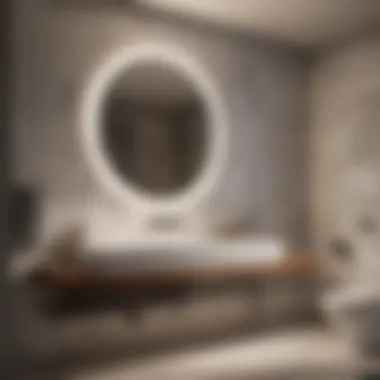
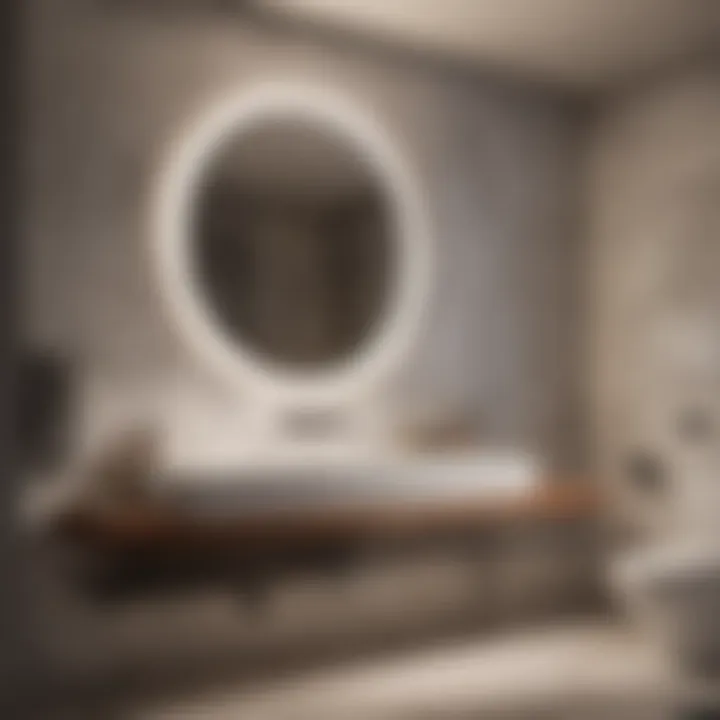
Intro
In the world of home design, lighting often takes a back seat to other elements such as furniture and colors. However, bathroom cove lighting is emerging as a crucial player in creating a harmonious and inviting space. It offers not only aesthetic appeal but also enhances functionality and promotes wellness. With proper installation and thoughtful design principles, cove lighting can breathe life into what can often be an overlooked area of the home.
When considering the bathroom, one may initially think about the practicality of fixtures and materials. But integrating cove lighting changes the narrative. It transforms the bathroom into a sanctuary, where light plays off surfaces and casts gentle shadows, establishing a mood that can be both invigorating and calming. This article will unravel the key elements of bathroom cove lighting, laying out how it can elevate design and wellbeing, and provide practical insights for those wishing to incorporate this lighting style into their homes.
Foreword to Cove Lighting
Cove lighting has become a significant element in contemporary home design, particularly in spaces where relaxation and comfort are paramount, such as bathrooms. It’s not just about illumination—it’s about crafting an ambiance that invites tranquility and complements design aesthetics. Cove lighting can transform an ordinary bathroom into a haven of serenity, subtly enriching the environment.
When discussing bathroom design, the choice of lighting is often overlooked despite its critical role. Cove lighting offers a unique solution by providing well-diffused illumination, eliminating harsh shadows and creating a warm, welcoming atmosphere. The benefits extend beyond aesthetics; good lighting can influence mood, enhance functionality, and improve the overall feel of a space.
Considerations around cove lighting encompass various elements such as location, intensity, and type of light sources used. For those pursuing an inviting bathroom sanctuary, understanding cove lighting's impact can open a treasure trove of design possibilities.
Definition and Origins
Cove lighting refers to the recessed installation of lights often found in ledges or architectural elements of a room. The origin dates back to the mid-20th century, gaining popularity among architects and designers who sought innovative methods to enhance spaces. The term 'cove' itself is derived from a design element that creates a curved or arched ceiling, offering a seamless source of light.
This indirect lighting technique reduces glare while generating a soft glow that washes the walls, enhancing the overall texture and color of the bathroom without being overpowering. It contrasts sharply with traditional overhead lighting, which can often feel stark and uninviting.
Evolution in Interior Design
The landscape of interior design has seen cove lighting evolve from a mere trend to a staple in creating modern spaces. Initially embraced by mid-century modernists who sought to emphasize minimalism and fluid lines, cove lighting today accommodates various styles—from the serene calm of spa-inspired retreats to the vibrant tones of contemporary designs.
As architectural preferences shifted over the decades, so did the implementation of cove lighting. Initially used in high-end residential designs, it has made its way into everyday spaces, underscoring its versatility. The integration of advanced technology has allowed for the introduction of smart lighting systems that can adjust brightness and color temperature, further enhancing the user experience.
"Cove lighting is like a silent partner in interior design—effectual, yet unobtrusive, setting the stage for how we experience any room."
In bathrooms, the evolution of cove lighting has aligned with the growing trend of creating functional yet luxurious experiences. Homeowners are increasingly seeking ways to blend utility with comfort, and cove lighting serves as an ideal solution, providing not just illumination but also contributing to the overall wellness of the space.
Understanding cove lighting’s trajectory helps us appreciate its value better. This knowledge lays the groundwork for diving deeper into its practical applications and benefits within bathroom designs.
Understanding Bathroom Lighting
Lighting in the bathroom is often overlooked, and yet it plays a critical role in both form and function. When you consider that this is a space where personal care and hygiene take place, the importance of effective lighting becomes evident. Not only does good lighting contribute to the overall aesthetic of the bathroom, but it also enhances the safety and functionality of the space. Whether it's illuminating a mirror for a close shave or adding warm tones for a relaxing soak, the decisions made regarding lighting can significantly impact your experience within the room.
Importance of Lighting in Bathrooms
Imagine starting your morning routine in a dimly lit bathroom. You struggle to see what you're doing, potentially leading to mishaps like nicks while shaving or applying makeup that looks more clownish than natural. Herein lies the importance of proper bathroom lighting—it's not merely about illuminating a space; it's about creating an environment that facilitates daily activities while maintaining a sense of tranquility.
Key Elements to Consider:
- Visibility: Good lighting ensures that every corner of the bathroom is adequately lit, minimizing shadows and making it safer to move around.
- Functionality: Each task, from grooming to relaxation, may require different lighting solutions. Understanding these needs allows for well-placed lights, enhancing efficiency in a busy bathroom.
- Aesthetics: Lighting can accentuate design choices, from highlighting a beautiful tile pattern to casting gentle light over wooden surfaces, thereby improving the overall visual appeal.
A well-lit bathroom is often not just a practical necessity; it can be a haven where one can unwind and take a break from a hectic day. This is why integrating cove lighting, which provides ambient light while making space feel spacious and welcoming, is often a sought-after choice.
Functional vs. Aesthetic Lighting
Now, let’s delve into two distinct categories of lighting in bathrooms: functional and aesthetic. Understanding the balance between these two can help house owners design a space that feels both luxurious and practical.
Functional Lighting
- This type is all about execution. It's about ensuring that the bathroom is lit effectively for specific tasks. Bright, focused lighting over the sink, for instance, is crucial for tasks like shaving or makeup application.
- Examples:
- Wall-mounted fixtures next to mirrors.
- Ceiling-mounted lights for overall visibility.
Aesthetic Lighting
- On the flip side, aesthetic lighting sets the mood. This involves creating an ambiance that reflects one's personality or the theme of the home.
- The warmth of recessed lights or subtly glowing cove lights can transform the bathroom from a utilitarian space into a relaxing sanctuary.
- Examples:
- LED strip lights placed under cabinetry or shelves.
- Decorative pendant lights that serve as focal points without overwhelming the space.
Ultimately, a successful bathroom design harmoniously balances both functional and aesthetic lighting. This ensures that the room isn't just a spot for getting ready but an inviting place to unwind at the end of the day.
"Effective bathroom lighting is more than just bulbs and fixtures; it flat-out influences the mood and usability of the space."
When planning your bathroom's lighting, consider how these two aspects can work together to create a cohesive environment. With an understanding of both functional and aesthetic lighting, you can design a bathroom that caters to your practical needs while still feeling like a retreat.
Types of Cove Lighting
Cove lighting plays a pivotal role in shaping the overall ambiance and functionality of a bathroom. Understanding different types of cove lighting is essential for anyone looking to enhance their bathroom's aesthetic appeal while ensuring that the lighting fits their specific needs. The right choice can uplift the space, create a sense of depth, and add a layer of sophistication. Below, we delve into the most common types of cove lighting, explaining their unique elements and benefits.
LED Cove Lighting
LED cove lighting has surged in popularity in recent years. The benefits of LEDs are numerous. Firstly, they are incredibly energy-efficient, which can help keep those electricity bills in check. They generate less heat compared to incandescent lights, making them safer and cooler, particularly important in smaller bathrooms where space can feel cramped.
From a design perspective, LED strips are versatile. They can be installed in various configurations, whether near the ceiling or along the edges of shelves and cabinets. This not only creates an inviting glow but also provides functional lighting for tasks like applying makeup or shaving. The color options available with LEDs also allow homeowners to customize their bathroom's mood: warm white for a cozy feel or cool white for a more clinical look.
"The right lighting can transform a bathroom from mundane to magnificent, especially with the modern efficiency of LED technology."
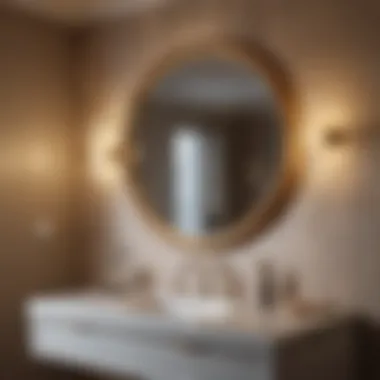
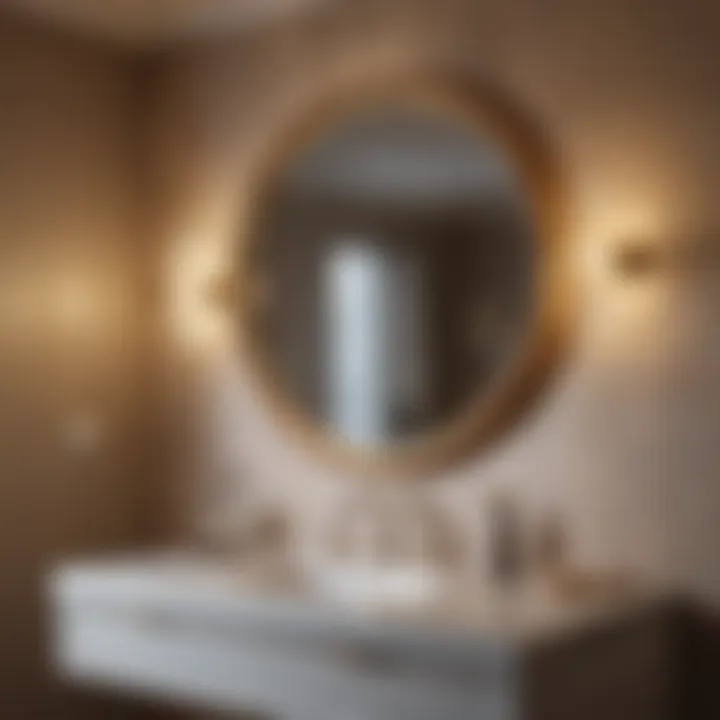
Incandescent and Halogen Options
Despite the shift toward more energy-efficient lighting solutions, incandescent and halogen bulbs still have their place in bathroom cove lighting. These traditional bulbs emit a warm light, creating a sense of comfort and warmth that's often desirable in intimate spaces like bathrooms. The warm glow can evoke feelings of relaxation and tranquility, which is why many homeowners still opt for these options.
Halogen bulbs, which are a type of incandescent lamp, offer some advantages, including better efficiency and longer lifespan compared to standard incandescent lamps. They also provide a bright, crisp light that can make spaces look larger and more inviting. However, these bulbs do tend to generate more heat, which is something to consider when planning installation. Lower wattage options can help mitigate heat issues without sacrificing brightness.
Fluorescent Lighting in Coves
Fluorescent lighting has taken a backseat in recent years, eclipsed by the rise of LEDs. Yet, it's worth discussing for its unique properties. Fluorescent bulbs provide an even light distribution, making them suitable for larger areas or bathrooms that require reliable lighting over a broader space.
While they are not as visually appealing as other options, modern designs have made great strides in aesthetics. Slim, stylish fluorescent tubes can fit into cove lighting without drawing unsightly attention. Moreover, they are an economical choice, typically outlasting incandescent bulbs and consuming less energy. However, understanding that they may not deliver the warmth some homeowners desire is key when considering them as an option.
In summary, selecting the appropriate type of cove lighting for your bathroom depends heavily on personal preference, desired ambiance, and practical needs. Each type brings its own benefits and challenges, making it crucial to weigh options before making a final decision. By considering aspects like energy consumption, bulb lifespan, and the overall look, homeowners can create inviting and functional spaces.
Design Principles for Effective Cove Lighting
When it comes to crafting a soothing and visually appealing atmosphere in a bathroom, the design principles of cove lighting play a crucial role. Cove lighting, in essence, describes a form of indirect light that is usually mounted on shelves or high up on walls, casting a gentle glare-free beam downwards. This style of lighting holds the power to transform the feel of your bathroom space, enhancing its aesthetics and functionality. It lays the groundwork for an inviting and serene environment where homeowners can unwind and rejuvenate.
Positioning and Layout Considerations
The position of your cove lighting can either make or break the ambiance of your bathroom. Here are some key points to keep in mind:
- Height Matters: Ideally, cove lights should be installed higher up on the walls. This allows the light to reflect off the ceiling and walls, spreading it softly throughout the room. Placing lights too low may lead to harsh shadows, which can detract from the calming vibe you wish to nurture.
- Strategic Placement: Consider the configuration of your bathroom. Corners or recesses are perfect spots for cove lighting as they can make a space feel more expansive. If there’s a freestanding tub, placing lights above it can create a spa-like retreat, inviting relaxation after a long day.
- Avoid Overloading: While it might be tempting to add more lighting for brightness, too many fixtures can clutter the space. Aim for a balanced layout that draws the eye without overwhelming it.
In short, effective placement of cove lighting fosters a balanced distribution of light, essential for a harmonious bathroom design.
Color Temperature and Its Influence
Color temperature significantly influences how a room feels. Understanding the spectrum—from warm yellows to bright whites—will help you in setting the right tone:
- Warm Light (2700K - 3000K): This hue creates a cozy and intimate environment. It’s ideal for bathrooms meant for relaxation, enhancing a peaceful retreat feel. Waking up to or winding down in warm light can significantly enhance your mood.
- Neutral Light (3500K - 4100K): This temperature presents a balanced feeling that’s neither too warm nor too harsh. A good all-rounder, which can work well in family bathrooms, providing enough illumination for tasks like grooming yet still feeling warm enough for comfort.
- Cool Light (5000K and above): Tend to provide clarity and brightness, often linked with daytime. It’s beneficial for task-oriented situations like shaving or applying makeup, but using it excessively might strip away the relaxing atmosphere.
Choosing the right color temperature depends on how you envision utilizing the space. In areas designed for relaxation, lean towards warmer tones, while task-oriented zones can benefit from cooler hues.
Integration with Other Lighting Fixtures
Cove lighting doesn’t have to stand alone. When blended with other lighting elements, it can create a richer, more dimensional space:
- Task Lighting: Pair cove lighting with targeted task fixtures, like sconces or recessed spotlights, especially in areas where close-up activities like applying makeup or shaving occur. This dual system can balance ambiance with practicality.
- Accent Lighting: Integrate cove lighting with accent features, such as backlit mirrors or artwork. Highlighting specific elements can create visual interest that complements the cove light’s softness.
- Dimming Controls: Adding dimmers to both cove and other fixtures allows you to customize the lighting based on the time of day or your activity. Dimming options also create an adaptable environment, instantly shifting from functional to calming.
By considering these principles, you can ensure that your bathroom cove lighting not only serves its purpose but do so with style and ease, striking a balance between beauty and function.
Installation Techniques for Cove Lighting
When it comes to implementing cove lighting in bathrooms, knowing how to properly install it is essential both for aesthetics and functionality. Cove lighting can dramatically alter the atmosphere of a room, making it more inviting and cozy. This type of lighting not only enhances the visual appeal, but it also serves functional purposes, like illuminating specific areas or providing ambient light, making tasks easier and creating the right mood. Understanding the installation techniques helps ensure that all these aspects are effectively achieved.
Tools and Materials Needed
For a successful installation, equip yourself with the right tools and materials. Below is a concise list to guide you:
- Tools:
- Materials:
- Measuring tape
- Level
- Stud finder
- Screwdriver
- Drill
- Wire stripper
- Safety goggles
- Cove lighting fixtures (LED strips, for instance)
- Mounting brackets or adhesive
- Light bulbs (if necessary)
- Electrical wires
- Junction box (for safe connections)
- Optional: dimmer switch for adjustable lighting
Make sure to check your local building codes regarding electrical installations, as safety should always be your priority when handling electrical components.
Step-by-Step Installation Process
Here’s a simplified step-by-step guide to getting your cove lighting set up:
- Planning the Layout: Measure your bathroom space. Decide where the cove lighting will go, considering placement to enhance both functionality and aesthetics.
- Marking the Area: Use the measuring tape to mark the position of your cove lighting. Ensure that the markings are level by using a level tool. This will make a significant difference in the final look.
- Preparing the Surface: If you're using adhesive strips, clean the installation area thoroughly to ensure proper adhesion. Preparing well can prevent issues later on.
- Installing the Fixtures: Attach the lighting fixtures or LED strips according to the manufacturer's instructions. Use brackets if needed for additional support. If you’re mounting to drywall or other materials, ensure you securely attach them.
- Wiring Connections: Turn off the power from the circuit breaker before working on any electrical connections. Connect the wires to the junction box, ensuring that you follow the right safety practices. This step is crucial; if you're unsure, consulting an electrician is wise.
- Testing the Lighting: Once everything is connected, turn the power back on to test your installation. Check if all lights function well. Adjust as necessary.
Common Pitfalls to Avoid
Avoid these common mistakes to ensure a successful cove lighting installation:
- Neglecting Safety: Always turn off the power supply before starting the installation.
- Improper Measurements: Double-check your measurements to avoid cutting or attaching materials incorrectly.
- Ignoring Voltage Ratings: Ensure that the lighting fixtures you choose are compatible with your home's power supply.
- Using Low-Quality Materials: Invest in good quality fixtures and wiring for longevity and safety.
- Overlooking Placement: Avoid placing the lights where they can be obstructed by objects or furniture, compromising their effectiveness.
"Heavy is the burden of poor planning; ensure your steps are methodical for a graceful setup."
By following these guidelines, you can ensure that your bathroom cove lighting serves both form and function, creating an ambiance that's both relaxing and visually appealing.
Psychological Effects of Bathroom Lighting
Understanding the psychological effects of bathroom lighting is essential, especially considering this intimate space's dual role as a functional area for daily routines and a sanctuary for relaxation. Lighting profoundly influences our emotions and behaviors; thus, choices made regarding cove lighting can significantly impact mood and well-being. In a space meant for unwinding, such as a bathroom, how we light that environment can shape our emotional experience and overall satisfaction with the space.
Lighting and Mood Enhancement
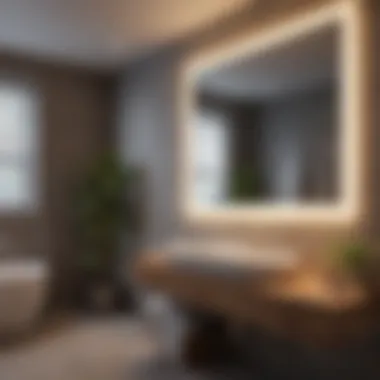
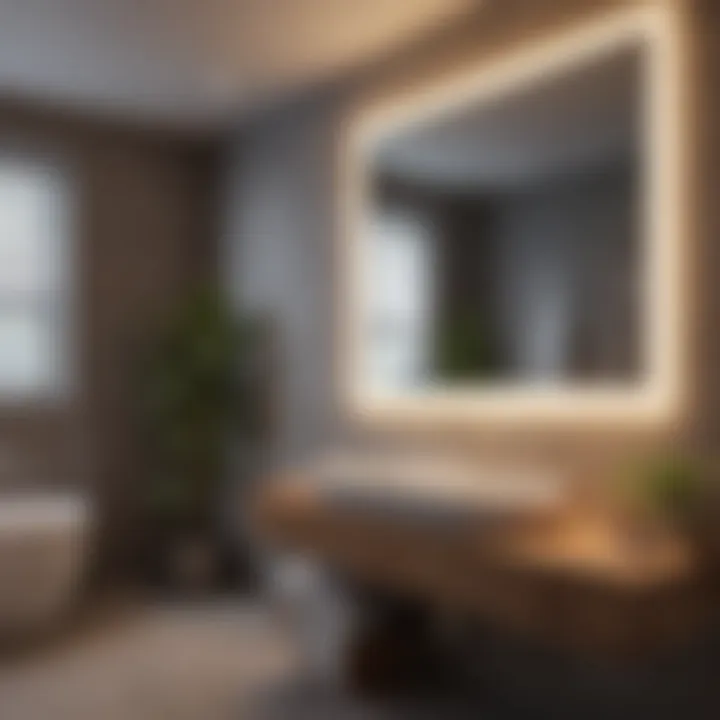
Bathrooms serve more than just a practical function; they are often our haven for self-care and personal reflection. Cove lighting, in particular, plays a significant role in mood enhancement. The manner in which light is distributed can create a soft ambiance that feels inviting and warm. For example, opting for a warmer shade of light—such as the soft golden hue of LED lights—can foster a sense of comfort and relaxation.
Consider the difference between stark fluorescent lights and gentle cove lighting. The former can often feel harsh, evoking a clinical atmosphere that may inhibit relaxation. In contrast, well-placed cove lighting can wrap the room in a gentle embrace, promoting feelings of serenity and tranquility. When light levels are adjustable, homeowners can easily tailor the atmosphere to suit their mood and needs. Utilizing dimmable options allows for a customizable experience, where the bathroom can shift from a bright space for grooming to a calming retreat for a soak in the tub with just a flick of a switch.
"The right lighting can turn an ordinary space into an extraordinary one, influencing not just aesthetics but also emotional response."
Creating a Relaxing Atmosphere
The atmosphere of any space is significantly shaped by its lighting arrangement, and the bathroom is no exception. Cove lighting can produce an effect that differs vastly from other lighting sources by providing an indirect and gentle glow. It softens hard edges and casts minimal shadows, which can reduce the feeling of claustrophobia; this is particularly beneficial in smaller bathrooms.
In particular, layering your lighting can augment the relaxation experience. By combining cove lights with accents or task lights, homeowners can create a multi-dimensional, inviting space. For instance:
- Cove lights softly illuminate the periphery, enhancing depth.
- Accent lights can highlight beautiful fixtures or decor.
- Task lights provide necessary illumination for grooming without overpowering the serene mood established by the cove lighting.
Moreover, integrating natural elements into this scheme, like the use of mirrors to amplify light or soft, muted colors on the walls, can further enhance the soothing atmosphere. Imagine stepping into a bathroom that feels more like a spa than a simple washroom; textures, scents, and gentle lighting all working in harmony create an oasis of relaxation. In areas with limited natural light, cove lighting becomes even more crucial, allowing the space to feel lighter and airier despite being enclosed.
Ultimately, thoughtful consideration of how lighting influences mood and creates atmosphere can unlock a bathroom's potential as a relaxing retreat in every home.
Practical Tips for Selecting Cove Lighting
Choosing the right cove lighting can drastically change the way your bathroom feels and functions. It’s not just about practicality; it's also about aesthetics. When you get this balance right, you enhance the entire environment. Good cove lighting creates a soft glow that sets the mood, making your bathroom not just a service area, but a retreat. Here are some practical tips on how to select cove lighting effectively.
Assessing Your Bathroom’s Size and Layout
The first step in selecting cove lighting is understanding the dimensions and layout of your bathroom. A small space can feel cramped if lit poorly. Conversely, a larger room could need several light sources to avoid gloomy corners. Measure the height of your ceilings and the total square footage, then consider how the cove lighting will fit into the overall architecture.
Consider the following factors:
- Room Shape: Is your bathroom rectangular, square, or has any alcoves? The shape can influence how light spreads.
- Ceiling Height: Taller ceilings may benefit from light fixtures that are brighter or positioned in more areas than shorter ceilings.
- Natural Light: Does your bathroom have windows? Natural light can change how artificial light appears, and some fixtures may mix better with incoming light than others.
This understanding sets the stage for an informed choice that avoids over-lit or under-lit spaces.
Matching Lighting with Decor Style
Once you’ve evaluated the spatial parameters, look at your existing decor style. The kind of cove lighting you choose should harmonize with the elements already in your bathroom.
Here are some points to consider:
- Modern vs. Traditional: Sleek, minimalist fixtures complement a modern aesthetic, while ornate designs pair well with classic styles.
- Color Schemes: Warm whites generally align with a cozy, homely design, while cool whites or even colored lights might suit a more contemporary or eclectic space.
- Material Compatibility: Ensure the light fixture’s materials mirror or complement other materials in the bathroom, like tile, fixtures, and cabinetry.
Choosing the right style not only makes for an appealing look but creates a consistent theme that feels cohesive and thoughtfully designed.
Budget Considerations
Last but not least, establishing a budget is crucial when selecting cove lighting. High-quality fixtures can range broadly in price, so it helps to know what you're willing to spend.
- Initial Costs: Consider how much you wish to allocate for both materials and labor. Custom installations can be pricier but offer unique aesthetics.
- Long-term Savings: Investing in LED lighting may cost more upfront but will pay off over time through energy savings.
- Maintenance Costs: Look ahead, too. Choose fixtures that are easy to clean and maintain, as this can save you time and money down the line.
"A well-planned lighting scheme can turn an ordinary bathroom into a haven of tranquility."
With these tips in mind, you can navigate the selection process with confidence. By considering size, decor, and budget, you're on the road to choosing the perfect cove lighting that complements your bathroom’s character while enhancing its appeal.
Trends in Cove Lighting
In the ever-evolving world of home design, cove lighting has been carving its niche as a key player, especially in bathrooms. Recognizing its role is crucial as it complements both aesthetics and functionality. The way we see lighting has changed radically, with an increased emphasis on sustainability and smart technology. These trends are more than just fads; they embody a shift towards greater elegance and efficiency in our living spaces, making them comfortable sanctuaries.
Sustainable Lighting Solutions
Environmental concerns have compelled many homeowners and designers to rethink their approach to lighting. Sustainable lighting solutions, like LED fixtures, are becoming ever more popular not only for their low energy consumption but also for their longevity. By opting for energy-efficient options, homeowners may find they save a pretty penny on energy bills, allowing more room in the budget for that beautiful modern sink or a tile upgrade.
Here are a few benefits of choosing sustainable lighting:
- Energy Savings: Who doesn't enjoy a lower electricity bill? Efficient bulbs consume much less energy.
- Longer Lifespan: LEDs have a lifespan that can stretch to decades, which means fewer replacements and less waste.
- Reduced Heat Emission: Unlike traditional incandescent fixtures, LEDs emit far less heat, keeping your bathroom cooler and comfortable.
- Versatile Design Options: Many sustainable fixtures are sleek and stylish, fitting seamlessly into various design themes.
As we lean into these sustainable practices, designers are getting creative too. They’re blending function and form with eco-friendly designs—think fixtures that harness natural light or programmable systems that adapt to the time of day.
"Sustainability isn't just a trend; it’s a valuable investment in our home and the planet."
Smart Technology Integration
Smart home technology has transcended the living room. Now, it is firmly making its way into bathrooms, and cove lighting is no exception. With the integration of smart technology, controlling your ambiance becomes incredibly intuitive. Imagine a scenario where adjusting the light isn’t just a matter of flicking a switch—the lights respond to your voice or a simple tap on an app.
Here’s how smart technology is infusing life into cove lighting:
- Voice Control: Systems like Amazon Alexa or Google Assistant can turn your cove lights on or off, set them to a specific color, or dim them without requiring you to lift a finger.
- Programmable Settings: You can set scenes that cater to different moods. Whether it’s a bright light for morning energy or a softer glow for a relaxing bath, smart lighting offers flexibility.
- Energy Monitoring: Some systems can track energy usage in real-time. This means you’ll not only enjoy the light but understand how much it’s costing you—making it easier to stay within budget.
As we embrace these emerging trends, cove lighting becomes much more than mere illumination; it transitions into a pivotal aspect of a holistic, integrated home environment. As a result, the convergence of design, technology, and sustainability makes the bathroom a refuge that enhances not just our daily routines but our overall well-being.
Maintenance and Care for Cove Lighting
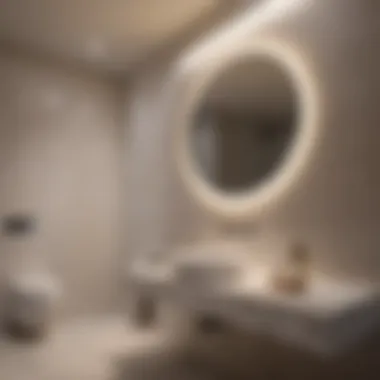
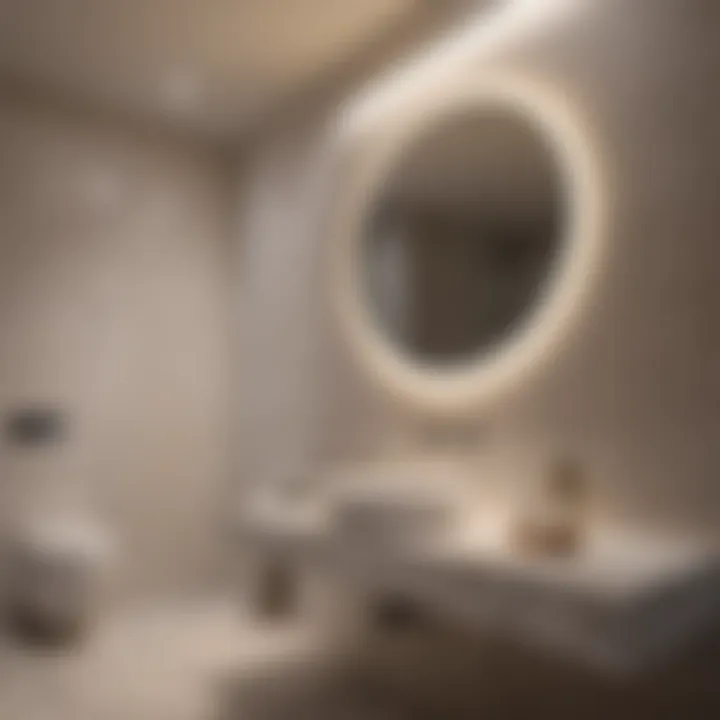
Maintaining cove lighting in your bathroom is like keeping the heart of your home's ambiance ticking smoothly. Without proper care, even the most beautiful fixtures can become dull and ineffective over time. Regular maintenance not only extends the lifespan of your lighting but also preserves its aesthetic appeal and performance. A well-maintained cove light can enhance your bathroom's atmosphere, making it a welcoming retreat.
Keeping an eye on your cove lighting helps ensure that it continues to serve its dual purpose: functionality and aesthetics. There are several key considerations when it comes to maintenance, including cleanliness, inspection of fixtures, and timely replacement of bulbs. Each of these elements contributes significantly to the overall effectiveness of your lighting.
Cleaning Techniques
When it comes to cleaning cove lighting, a consistent approach is crucial. Dust and grime tend to settle on light fixtures, causing light output to diminish.
Here are few tips for effective cleaning:
- Dust regularly: Use a soft, dry cloth or a microfiber cloth to gently wipe the surfaces of your light fixtures. This prevents buildup that can impair their brightness.
- Avoid harsh chemicals: Stick with warm water and a mild soap solution to avoid damaging the finish or materials of the fixture.
- Check the location: If your lights are higher up, employ a step ladder for safe access. Just make sure to turn off the lights before cleaning.
- Be cautious: If your fixtures use glass or acrylic, ensure they are cool to the touch to avoid cracking from sudden temperature changes.
Cleaning these fixtures periodically can greatly improve the quality of light, making your bathroom feel more inviting and fresh.
Tip: Aim to clean your fixtures at least once every three months for best results.
Replacing Bulbs and Fixtures
No matter how careful you are, bulbs will eventually reach the end of their life span. Knowing when and how to replace them is just as important as maintaining the cleanliness of your lighting.
Consider the following points for replacements:
- Time your replacements: Most bulbs have an average lifespan. For instance, LED bulbs usually last longer than incandescent or fluorescent lights. It’s beneficial to keep track of when bulbs were installed.
- Choose the right bulbs: Make sure to replace bulbs with those that match the specifications of your existing fixtures regarding type, wattage, and color temperature. Doing otherwise might affect the performance or safety of the lighting.
- Inspect the condition: While replacing bulbs, it’s a great opportunity to check the fixtures themselves. Look for any signs of wear, such as rust or corrosion, especially around electrical connections. If you notice any issues, it may be time to consider replacing entire fixtures.
Taking care of cove lighting through regular cleaning and replacing bulbs ensures that your bathroom not only looks good but feels good too. With proper care, your cove lighting can significantly enhance your space, making it the soothing retreat you deserve.
Case Studies: Successful Bathroom Cove Lighting Designs
When it comes to cove lighting in bathrooms, real-world examples can speak volumes about its potential impact. Case studies are not just about showing off successful designs; they’re a vital part of understanding how these lighting solutions can enhance various aesthetics and functionalities. By analyzing these instances, readers can glean inspiration and practical insights that can be adapted to their personal spaces.
In this section, we’ll explore three distinct approaches to bathroom cove lighting design. Each perspective not only demonstrates a unique style but also reveals the benefits and considerations that come with each choice.
Modern Minimalist Approaches
Modern minimalism takes center stage in cove lighting design, favoring clean lines and simplicity. Bathrooms designed in this style often utilize a soft, ambient glow that reinforces the serene vibe. For example, a bathroom featuring sleek white cabinetry combined with matte grey tiles can benefit from LED cove lights hidden above a frameless mirror. The gentle light reflects off the surfaces, adding depth without overwhelming the senses.
Moreover, minimalism encourages the use of neutral colors in the surroundings, allowing cove lighting to shine with ease. One important aspect of this design is the focus on functionality—these lights serve to illuminate work areas while creating an inviting atmosphere.
"In modern minimalistic spaces, less is often more, allowing for focus on quality and experience rather than quantity."
Vintage and Classic Styles
On the other hand, vintage and classic decor styles bring warmth and character to bathroom design. Cove lighting is often incorporated in a way that balances nostalgic elements with modern convenience. For instance, a bathroom adorned with ornamental tiles and antique fixtures might utilize cove lighting to accentuate its architectural details. A warm white hue can bring out the richness of materials like mahogany or marble.
These designs might also prioritize the use of sconces along with cove lighting, creating layers of illumination that lend depth to the space. It�’s essential, however, to carefully consider maintaining a cohesive look; mixing too many styles can lead to visual discord.
Eclectic and Bold Designs
Eclectic designs thrive on creativity and personal expression, and the use of cove lighting can elevate these spaces into eye-catching displays. Think bold colors and unique fixtures combined with dynamic architectural lines. Here, cove lighting can be used dramatically—for instance, a brightly painted ceiling could be lined with cove lights to highlight its color and create a captivating effect when contrasted with softer wall shades.
A successful eclectic bathroom might also feature various textures, like reclaimed wood or industrial-style accents, that benefit from the subtlety of cove lighting. This type of approach invites experimentation, be it in light color or placement, allowing homeowners to play with a variety of styles to find their perfect fit.
In summary, these case studies illustrate how bathroom cove lighting can transcend mere functionality. It's not just about brightening a space; it's about shaping an experience that is deeply personal and reflective of individual tastes. Homeowners and designers alike can draw inspiration from these approaches, melding style with practical consideration to create bathrooms that truly resonate.
Culmination: The Future of Cove Lighting in Bathrooms
As we wrap up this exploration of cove lighting in bathrooms, it’s vital to look ahead and consider where this design element is headed. Cove lighting has evolved into more than just a decorative feature; it’s now seen as a core component of a holistic bathroom design. The importance of this topic can't be overstated, as homeowners continually seek to improve their living spaces by making them not just functional but also restorative.
The anticipated innovations in lighting technology are paving the way for more sustainable and user-friendly designs. Demand for energy efficiency has never been higher, with many homeowners opting for LED options that significantly reduce electricity bills. These lights not only use less energy, but they also last longer than traditional bulbs, which means they can save money in the long run.
Moreover, the integration of smart home technology into bathroom cove lighting systems is gaining traction. Homeowners are increasingly interested in having control over their lighting environments at their fingertips, allowing them to adjust brightness and color temperatures through mobile devices or voice assistants. This isn't just about convenience; it’s a way to personalize the experience of using one’s own bathroom.
"Lighting is the art of the heretics." — Oris A. McCarter
Anticipated Innovations
Looking into the future, a couple of particularly exciting innovations stand out. One glaring trend is the use of tunable white technology, which enables users to adjust the color temperature of their lights throughout the day. This adaptability can mimic natural sunlight, making it easier to wake up in the morning or relax when winding down at night.
Other anticipated innovations include:
- Smart Controls: Integration with apps that allow for programmable lighting schedules.
- Energy-Efficient Materials: New advancements in LED technology promising even further reduction in energy use.
- Advanced Sensor Systems: Lighting that reacts to movement and time of day, automatically adjusting to needs without manual input.
These innovations are not just trends but indicators of how cove lighting will become more ubiquitous in modern bathrooms, transforming them into calming retreats rather than mere functional spaces.
Embracing Holistic Design Principles
As we consider the future, it becomes clear that a holistic approach to design is at the forefront. Homeowners are increasingly aware that every element in their bathroom, from the fixtures to the lighting, should work together harmoniously. This thought process leads to employing cove lighting not just for aesthetics, but as a means to enhance overall well-being.
Incorporating elements of nature into bathroom design has been a growing trend, and cove lighting plays a crucial role in achieving this. By using warm, natural colors or even LED lights that reflect natural light patterns, one can create a relaxing environment that soothes stress and fosters calm.
Considerations for holistic design include:
- Color Harmony: Ensuring that light colors work seamlessly with wall and decor colors.
- Layering Light: Using cove lighting in conjunction with task lighting for a multi-dimensional approach.
- Textures and Materials: Combining various materials in the space, while ensuring that the lighting complements these choices.
In essence, cove lighting in bathrooms is positioned not merely as a light source but as an integral part of the ambient experience, focusing on relaxation and personal well-being. As design principles continue to evolve, cove lighting will play a vital role in the transformation of bathrooms into sanctuaries of peace.



